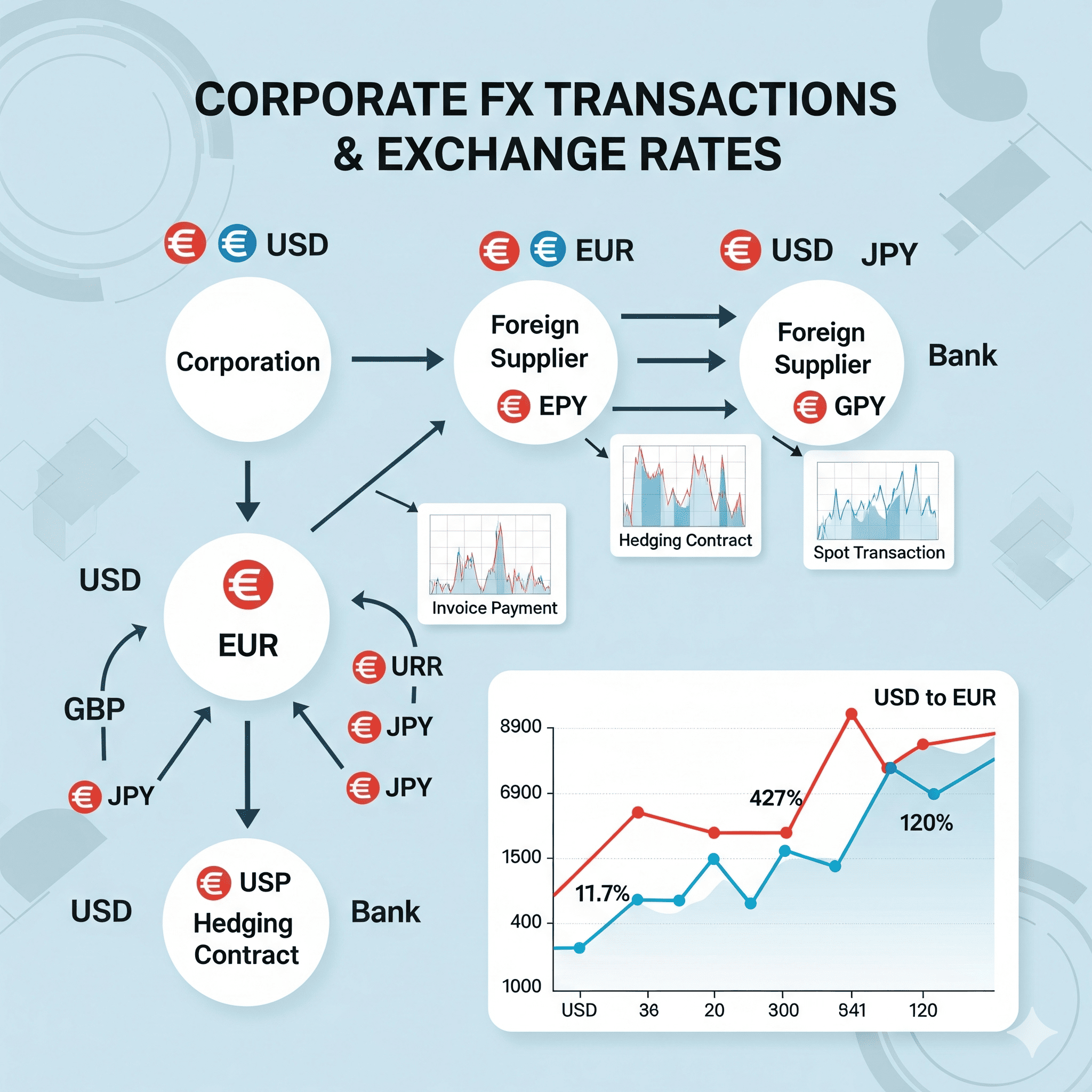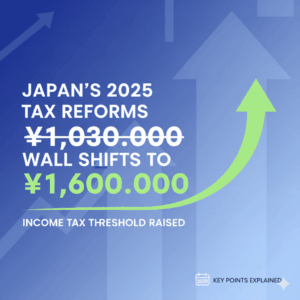Foreign Currency Exchange Rate Treatment for Corporate Transactions
In today’s globalized world, many companies engage in foreign currency transactions. However, there are complex rules regarding yen conversion methods for tax purposes, and failure to implement proper procedures may result in tax risks.
This article provides a clear explanation of practical knowledge regarding yen conversion methods for foreign currency transactions based on Article 61-8 of the Corporate Tax Law and related interpretive guidelines.
What Are Foreign Currency Transactions | Definition and Scope of Application
Under the Corporate Tax Law, “foreign currency transactions” refer to transactions conducted in foreign currency, including the sale and purchase of assets, provision of services, lending and borrowing of money, dividend distributions, and other transactions where payment is made in foreign currency.
An important point is that even if the amount of claims and debts is denominated in foreign currency, if the actual payment is made in Japanese yen, it does not constitute a “foreign currency transaction.” This is called “foreign currency-denominated yen payment” and is subject to different treatment.
For example, if a contract states “1,000 USD” but the actual settlement is made as “150,000 yen at an exchange rate of 1 USD = 150 yen,” this is not a foreign currency transaction. Only cases where actual settlement is made in foreign currency are subject to these rules.
Yen Conversion Method at the Time of Foreign Currency Transaction
The yen conversion amount for foreign currency transactions is, in principle, “the amount converted using the foreign exchange buying and selling rates at the time the foreign currency transaction was conducted.”
The specific conversion rate uses the mid-rate (TTM) between the telegraphic transfer selling rate (TTS) and telegraphic transfer buying rate (TTB) on the transaction date. This mid-rate is the standard rate published by many financial institutions.
| Rate Type | Usage | Application Conditions |
|---|---|---|
| TTM (Mid-rate) | All transactions in principle | Basic under Corporate Tax Law |
| TTS (Telegraphic Transfer Selling Rate) | Purchases, expenses, liabilities | Continuous application required |
| TTB (Telegraphic Transfer Buying Rate) | Sales, revenues, assets | Continuous application required |
Subject to continuous application, it is also permitted to use the telegraphic transfer buying rate (TTB) on the transaction date for sales and other revenues or assets, and the telegraphic transfer selling rate (TTS) on the transaction date for purchases and other expenses or liabilities.
Legal Basis (Excerpt, Partially Modified, Underlined by Author)
(Yen Conversion of Foreign Currency Transactions and Transaction Date Conversion Method)
Corporate Tax Law Basic Interpretation 13-2-1-2
Yen conversion based on Article 61-8, Paragraph 1 of the Corporate Tax Law (Conversion of Foreign Currency Transactions) and Article 61-9, Paragraph 1, Item 1, Sub-item A of the Corporate Tax Law (Meaning of Transaction Date Conversion Method) (excluding yen conversion when Article 61-8, Paragraph 2 of the Corporate Tax Law applies) shall be based on the mid-rate between the customer telegraphic transfer selling rate (hereinafter “telegraphic transfer selling rate”) and customer telegraphic transfer buying rate (hereinafter “telegraphic transfer buying rate”) on the date when the transaction should be recorded (hereinafter “transaction date”) (hereinafter “mid-rate of telegraphic transfer buying and selling rates”). However, subject to continuous application, the telegraphic transfer buying rate on the transaction date may be used for sales and other revenues or assets, and the telegraphic transfer selling rate on the transaction date may be used for purchases and other expenses (including costs and losses) or liabilities.
1. The telegraphic transfer selling rate, telegraphic transfer buying rate, and mid-rate of telegraphic transfer buying and selling rates mentioned in the main text of this interpretation shall, in principle, be those of the corporation’s main transaction financial institution. However, if the corporation continuously uses reasonable rates obtained through the same method, this is acceptable.
2. For the above yen conversion, subject to continuous application, the following foreign exchange buying and selling rates (hereinafter “exchange rates”) that are reasonably recognized according to the content of the foreign currency transaction may also be used.
(1) The telegraphic transfer buying rate or telegraphic transfer selling rate on the last day of the previous month or previous week, or the first day of the current month or current week to which the transaction date belongs, or the mid-rate of telegraphic transfer buying and selling rates on these dates
(2) Average values of mid-rates of telegraphic transfer buying and selling rates, telegraphic transfer buying rates, or telegraphic transfer selling rates over a certain period within one month, such as the average rate of the previous month or previous week to which the transaction date belongs
Types of Exchange Rates Available for Use
For tax purposes, in addition to the conversion rate on the transaction date, various foreign exchange rates that are reasonably recognized can be used, subject to continuous application.
The main options include the following methods:
Monthly and Weekly Basis Rates: You can use various rates from the last day of the previous month or previous week, or the first day of the current month or current week to which the transaction date belongs. This allows for simplified administrative processing.
Use of Average Rates: It is also possible to use average values of various rates over a certain period within one month, such as the average rate of the previous month or previous week to which the transaction date belongs.
These methods can be selected according to the frequency and nature of the company’s foreign currency transactions, and once a method is selected, it must be applied continuously.
Important Practical Considerations
When conducting yen conversion of foreign currency transactions, there are several important practical points to consider.
Selection of Financial Institution: The rates used for conversion shall, in principle, be those of the corporation’s main transaction financial institution. However, if reasonable rates obtained through the same method are used continuously, this is also acceptable.
Processing When No Rate is Available: When there is no exchange rate on the transaction date, use the exchange rate from the nearest preceding date. Also, when there are multiple rates on the transaction date, use the final rate of that day (or the rate at the time of occurrence if the transaction occurred during the day).
Importance of Continuous Application: Once a conversion method is selected, it must be applied continuously, and arbitrary changes are not permitted. During tax audits, this continuity becomes an important point of verification.
Special Treatment for Foreign Currency-Denominated Yen Payment Transactions
For “foreign currency-denominated yen payment transactions” where the amount is denominated in foreign currency but actual settlement is made in Japanese yen, special treatment is prescribed.
In this case, at the time of transaction, an estimated amount is recorded following the example of yen conversion for foreign currency transactions, and any difference arising at the time of actual settlement is included in the taxable income or deductible expenses for the business year to which the settlement date (or date when the settlement amount is determined) belongs.
This processing method allows for appropriate reflection of foreign exchange risk in accounting and tax treatment.
Summary
Yen conversion of foreign currency transactions is one of the important issues in corporate taxation. While conversion using TTM (mid-rate) is the basic principle, various reasonable methods can be selected subject to continuous application.
It is important to select the optimal method according to the scale and frequency of the company’s foreign currency transactions and to apply the chosen method continuously. Additionally, foreign currency-denominated yen payment transactions require separate special processing, making it essential to accurately understand the nature of transactions.










